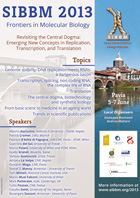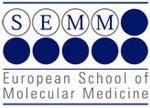
Registrations
11 March 2013
to
13 May 2013
After 13 May 2013 only onsite registrations will be accepted.
Abstracts
11 March 2013
to
13 May 2013
Payment
27 March 2013
to
20 May 2013
Payments will be accepted until 27 May 2013 at a higher fee. See the Information page.
Organisers
Giuseppe Biamonti
IGM-CNR, Pavia
Andrea Mattevi
University of Pavia

![]() _Download the flyer
_Download the flyer
and spread the news!
Programme
Wednesday, 5 June
| 10:30-13:45 |
Registration |
| 14:00-14:15 |
Welcome Address Gennaro Ciliberto (SIBBM President) Rector of the University of Pavia |
| Session I |
From replication to transcription Chair: Gennaro Ciliberto (Naples) |
| 14:15-14:50 |
Marco Foiani (Milan) Mechanisms coordinating chromosome replication and transcription |
| 14:50-15:25 |
Marco Muzi Falconi (Milan) The importance of being DNA: RNase H and post-replication repair protect the genome from ribonucleotide incorporation |
| 15:25-15:40 |
Poster talk: Paolo Benatti (Modena) A non transcriptional role for NF-Y in DNA replication |
| 15:40-16:20 |
Pat Cramer (Munich, Germany) Gene transcription: from molecular movies to regulatory sytems |
| 16:20-18:00 |
Coffee Break and Poster Session I |
| 18:00-18:15 |
Poster talk: Bruna Marini (Trieste) Nuclear architecture favors HIV-1 integration into a subset of active genes at the periphery of CD4+ T-cell nuclei |
| 18:15-18:30 |
Poster talk: Giovanni Pietrogrande (Milan) HMGB1 controls homologous recombination, but nucleosome density does not |
| 18:30-19:10 |
Tom Misteli (Bethesda, USA) Epigenetics beyond transcription |
| 19:10-19:45 |
Science & Society Talk: Tullio Pozzan (Padua) Brain aging and neurodegenerative diseases: a problem of signals |
| 20:00-22:00 |
Dinner at the University Court and Posters |
Thursday, 6 June
| 8:45-10:00 |
The Dora Declaration and Mark Patterson (Elifescience.org) |
| Session II |
Genome stability – DNA Replication meets RNAs: a dangerous liason Chair: Paolo Macchi (Trento) |
| 10:00-10:35 |
Giovanni Maga (Pavia) The multi-faceted roles of DNA polymerase family X in safeguarding genomic integrity |
| 10:35-10:50 |
Poster talk: Gabriele Fontana (Milan) Oxidative stress alters the choice of alternative last exons via Brahma downregulation and disassembly of the pre-mRNA 3' end processing factor CstF |
| 10:50-11:05 |
Poster talk: Francesca Garibaldi (Rome) MicroRNAs regulated by mutated p53 oncoproteins in cancer |
| 11:05-11:30 |
Coffee Break |
| 11:30-12:05 |
Adriana La Volpe (Naples) Gene silencing, DNA damage and germ-line apoptosis |
| 12:05-12:40 |
Fabrizio d'Adda di Fagagna (Pavia) DNA makes RNA protects DNA |
| 12:40-14:00 |
Lunch |
| Session III |
Emerging themes in RNA biology Chair: Giuseppe Macino (Rome) |
| 14:15-14:50 |
Stefano Gustincich (Trieste) SINEUPs: a new functional class of natural and synthetic antisense long non-coding RNAs that activate translation |
| 14:50-15:25 |
Claudio Sette (Rome) Alternative splicing: from genomic resource to risk factor in human diseases |
| 15:25-15:40 |
Poster talk: Valentina Casà (Milan) D4Z4 could be the first PRE involved in a human genetic disease |
| 15:40-18:00 |
Coffee Break and Poster Session II |
| Session IV |
Young Talents Chair: Caterina Missero (Naples) |
| 18:00-18:35 |
Chiara D’Onofrio Lecture |
| 18:35-19:00 |
Arturo Falaschi Lecture |
| 19:00-20:00 |
General SIBBM Society Meeting (SIBBM members only) |
| 20:00-22:00 |
Dinner at the University Court and Posters |
Friday, 7 June
| Session V |
The central dogma, biotechnology and synthetic biology Chair: Valeria Poli (Turin) |
| 9:00-9:35 |
Sheref S. Mansy (Trento) Imitating cellular life |
| 9:35-10:10 |
Giannino del Sal (Trieste) Targeting pathways driving metastasis in Breast Cancer |
| 10:10-10:25 |
Poster talk: Valentina Miano (Turin) Characterization of estrogen receptor alpha -regulated lncRNA in breast cancer cell |
| 10:25-10:40 |
Poster talk: Francesca Orso (Turin) microRNA sponges powerful tools to control tumor progression |
| 10:40-10:55 |
Poster talk: Francesco Rusconi (Milan) Neuronal LSD1: a mammalian epigenetic modulator of neuronal excitability |
| 11:00-11:30 |
Coffee Break |
| 11:30-12:05 |
Alberto Auricchio (Naples) From viral vectors to patients: gene therapy of inherited retinal degenerations |
| 12:05-12:40 |
Guido Grandi (Siena) Genomics and proteomics in vaccine discovery and immunotherapy |
| 12:40-13:00 |
Chiara D'Onofrio "Giovani" Award |
Posters
Posters with an odd number are presented during Poster Session I (Wednesday, 5 June). Posters with an even number are presented during Poster Session II (Thursday, 6 June).
The poster's maximum size is A0 (841 x 1,189 mm; width x height); see also the Information page.
P.1 Loredana Amigoni (Milan) Start-specific transcription factor Swi4 is a target for PKA regulation of cell size at G1/S transition in Saccharomyces cerevisiae |
P.2 Lavinia Arseni (Pavia) Transcriptional alterations in trichothiodystrophy affect different components of the extracellular matrix |
P.3 Federica Babbio (Milan) UHRF1-dependent miRNAs modulate Dnmt3a expression in prostate transformed cells |
P.4 Laura Bavagnoli (Pavia) The different substrate specificities of human influenza virus PA and PA-X endonucleases support distinct roles in the viral life cycle |
P.5 Arianna Bellazzo (Trieste) The tumor suppressor gene DAB2IP as a potential miRNA target in cancer progression |
O&P.6 Paolo Benatti (Modena) A non transcriptional role for NF-Y in DNA replication |
P.7 Federica Bertoletti (Pavia) Cross-talk of classic and alternative NHEJ repair of DNA breaks in cencer cells |
P.8 Valeria Bevilacqua (Rome) Study of a novel long non coding RNA involved in neuronal differentiation |
P.9 Tiziana Bonaldi (Milan) The regulatory potential of protein methylation in gene expression investigated by MS-based proteomics |
P.10 Serena Bonomi (Pavia) HnRNP A1 controls a splicing regulatory circuit promoting mesenchymal-to-epithelial transition (MET) |
P.11 Giorgio Camilloni (Rome) Histone amount, genome stability, gene expression and aging in NHP6 mutants of S. cerevisiae |
P.12 Valeria Capaci (Trieste) microRNAs promoting mutant-p53 gain-of-function in breast cancer |
P.13 Mariacristina Capizzi (Rome) The role of hsa-miR-7 and hsa-miR-9 in post- transcriptional regulation of AMBRA1 |
P.14 Mariano Francesco Caratozzolo (Bari) TRIM8 antiproliferative action against chemo-resistant Renal Cell Carcinoma with wild-type p53 |
O&P.15 Valentina Casà (Milan) D4Z4 could be the first PRE involved in a human genetic disease |
P.16 Morena Catillo (Pavia) Expression of splicing factor SRSF1 is controlled through a complex alternative splicing program in the 3’-UTR modulated by cell growth and differentiation |
P.17 Lidia Chellini (Rome) Inhibition of translation elongation in response to ribosomal stress |
P.18 Silvia Anna Ciafre' (Rome) Functional effects and microRNA modulation mediated by a Myc dominant negative in glioblastoma initiating cells |
P.19 Maria Ciaramella (Naples) Genome caretakers from hyperthermophilic microorganisms: from basics to applications |
P.20 Lucia Cicchillitti (Rome) Identification of a novel NF-Y protein partner: characterization of NF-YA/LMNA nuclear complex |
P.21 Giuseppe Ciossani (Pavia) Small molecule reversible inhibitors of LSD1/CoREST |
P.22 Agnese Ciotti (Rome) Long-range epigenetic mechanisms regulating p57 expression in muscle cells |
P.23 Michela Clerici (Milan) The general regulatory factor Tbf1 and its interacting protein Vid22 promote repair of DNA double-strand breaks |
P.24 Anna Comel (Trieste) Dissecting the tumor suppressor activity of the bromodomain containing protein BRD7 |
P.25 Paolo Cremaschi (Pavia) A new system biology approach to mine expression data for gene functional analysis |
P.26 Luisa de Latouliere (Rome) Regulation of human MENA expression by NF-Y transcription factor |
P.27 Vincenzo De Simone (Napoli) How (and why) to expose high school students to the emerging concepts at the frontiers of molecular biology: five years experience with the “Eureka” project |
P.28 Claudia De Vitis (Catanzaro) Tyrosine-related kinase B is responsible for epithelial to mesenchymal transition in malignant pleural effusions derived cultures from adenocarcinoma of the lung |
P.29 Michela Denti (Trento) Antisense RNA for the modulation of splicing: a correctional gene therapy approach for neurodegenerative diseases |
P.30 Davide Esposito (Naples) Human rpL3 induces p21-dependent G1/S arrest or apoptosis in Calu-6 cells |
P.31 Matteo Faè (Pavia) Overexpression of MtTdp2α (Tyrosyl-DNA Phosphodiesterase 2 α) gene in Medicago truncatula Gaertn. is associated with up-regulation of DNA repair and ROS scavenger genes and structural changes in nucleolar architecture |
P.32 Emmanuela Falcone (Rome) Crosstalk between mutp53 and NF-Y in the regulation of EMT |
P.33 Mattia Falcone (Turin) Identification of lncRNAs involved in neuronal differentiation through bioinformatic mining of the Allen Brain Atlas |
P.34 Giulio Ferrero (Orbassano) Biological and technical variables on lncRNA quantification by RNA-Seq experiments |
P.35 Giulia Ferri (Milan) A unifying molecular pathway for FSHD pathogenesis |
P.36 Alessandro Fiorenzano (Naples) A G-Protein coupled receptor APJ-BAF60c/Smarcd3 axis controls cardiomyogenesis in embryonic stem cells |
O&P.37 Gabriele Fontana (Milan) Oxidative stress alters the choice of alternative last exons via Brahma downregulation and disassembly of the pre-mRNA 3' end processing factor CstF |
P.38 Sofia Francia (Milan) Site-specific DICER and DROSHA RNA products control the DNA damage response |
P.39 Paolo Fuzio (Bari) Clusterin isoforms in thyroid cancer: a potential marker of malignancy in the indeterminate thyroid nodule? |
P.40 Davide Gabellini (Milan) Facioscapulohumeral muscular dystrophy Region Gene 1 is a novel epigenetic regulator of muscle stem cell biology and myogenesis |
P.41 Anna Gandaglia (Busto Arsizio) Mecp2 deficiency causes skeletal muscle alterations: first insights into the morphological and molecular defects |
P.42 Anna Garbelli (Pavia) Towards a pharmacological control of endogenous retroviruses in xenotransplantation |
O&P.43 Francesca Garibaldi (Rome) MicroRNAs regulated by mutated p53 oncoproteins in cancer |
P.44 Alberto Inga (Mattarello) Corrupted by TNFalpha-induced signaling: a dark side of wild type p53? |
P.45 Manuela Lanzafame (Pavia) Identification of CSA-interacting proteins through a novel TAP/RMCE approach |
P.46 Giordano Liberi (Pavia) Senataxin associates with replication forks to protect fork integrity across RNA polymerase II-transcribed genes |
P.47 Andrea Lossani (Pavia) Novel inhibitors of Fyn as possible tools in the study of tautopathies |
P.48 Marta Lunghi (Milan) The role of p35/CDK5 regulation by miR-15/107 in Alzheimer’s disease |
P.49 Marina Lusic (Trieste) Proximity to PML nuclear bodies regulates HIV-1 latency in CD4+ T cells |
P.50 Elena Magnani (Busto Arsizio) The role of UHRF1 in e-cadherin epigenetic regulation: a modulation via promoter associated non-coding RNAs |
P.51 Isabella Manni (Rome) Mito-Luc reporter mice: a new tool for screening of compounds that modulate cell proliferation, and its use in pharmacological approaches |
O&P.52 Bruna Marini (Padriciano, Trieste) Nuclear architecture favors HIV-1 integration into a subset of active genes at the periphery of CD4+ T-cell nuclei |
P.53 Francesca Marino (trieste) The N-terminus of human and Xenopus RecQ4 contains a putative zinc-knuckle domain |
P.54 Carolina Marotta (Trieste) DEPDC1 , a Pin1/mutant p53 modulated gene , can impact on aggressiveness in breast cancer. |
P.55 Barbara Medagli (Trieste) MCM2-7 vs MCM8-9: same family but different stories |
O&P.56 Valentina Miano (Colleretto Giacosa (TO)) Characterization of estrogen receptor alpha -regulated lncRNA in breast cancer cell |
P.57 Mohammad Sarfaraz Nawaz (Busto Arsizio) CDKL5 affects neuronal polarization through its interaction with Shootin1 |
P.58 Simone Nenci (Pavia) Enzymatic defects in Rhizomelic Chondrodysplasia Punctata: biochemistry and therapeutic avenues |
P.59 Ruggiero Norfo (Modena) Integrative analysis of mRNA/miRNA expression profiles of CD34+ cells in primary myelofibrosis |
P.60 Alessia Noto (Rome) Stearoyl-CoA desaturase-1 is a key factor for lung cancer stem cell survival and expansion |
P.61 Daniele Novarina (Milan) A screening for genome stability genes in Saccharomyces cerevisiae identified GSM32 as a new player in the genome integrity landscape |
P.62 Matteo Oliverio (Pavia) The cell response to replication defects affects alternative splicing programs and cell morphology |
P.63 Silvia Onesti (Trieste) Insight into the architecture and assembly of the CMG helicase |
P.64 Veronica Oropallo (Rome) ATM protein kinase promotes HER2-dependent tumorigenesis |
O&P.65 Francesca Orso (Turin) microRNA sponges powerful tools to control tumor progression |
P.66 Vittoria Pagliarini (Rome) Regulation of SMN2 alternative splicing by Sam68 and its implication in spinal muscular atrophy |
P.67 Silvia Parolo (Pavia) Disease and health in the Italian population: insight from genome-wide approaches |
P.68 Laura Patrucco (Novara) Exploiting the biotechnological potential of SINEUPTM, novel approach to improve protein synthesis mediated by long non-coding RNAs |
P.69 Silvia Pegoraro (Trieste) HMGA1 promotes metastatic processes in basal-like breast cancer regulating epithelial to mesenchymal transition and stemness |
P.70 Valentina Pennucci (Modena) Gene expression profiling of CD34+ from primary myelofibrosis patients |
P.71 Fiorenzo Peverali (Pavia) The human LaminB2 replicator triggers short-range interactions by CTCF to prevent transcriptional silencing |
P.72 Giulia Piaggio (Rome) MITO-Luc reporter mice: a new tool for screening of compounds that modulate cell proliferation, and its use in pharmacological approaches |
P.73 Valentina Piano (Pavia) Enzymatic defects in Rhizomelic Chondrodysplasia Punctata: biochemistry and therapeutic avenues |
O&P.74 Giovanni Pietrogrande (Milan) HMGB1 controls homologous recombination, but nucleosome density does not |
P.75 Simona Pilotto (Italy) Small molecule reversible inhibitors of LSD1/CoREST |
P.76 Sara Pizzi (Milan) RNase H and Post-Replication Repair protect cells from ribonucleotides incorporated in DNA |
P.77 Maria Romanelli (Verona) Identification of nuclear retention domains in the alternative splicing regulator RBM20 |
P.78 Naomi Ruggeri (Trieste) High content screening for FDA‐approved drugs reducing mut-p53 levels in breast cancer cells |
P.79 Valeria Runfola (Milan) Mef2D splicing regulation and its alteration in FSHD |
O&P.80 Francesco Rusconi (Milan) Neuronal LSD1: a mammalian epigenetic modulator of neuronal excitability |
P.81 Maria Elisa Sabatini (Pavia) M. truncatula MtTdp1α-depleted lines show chromatin remodeling associated to DNA damage response |
P.82 Simone Sabbioneda (Pavia) Regulation of polymerase η by the SUMO pathway |
P.83 Erica Salvati (Rome) Role of Poly ADP-ribose polymerase in telomere replication |
P.84 Marco Santagostino (Pavia) Telomeric Repeats are novel splicing regulators |
P.85 Lida Savi (Pavia) Mutagenesis of human adenosine kinase: study of the mechanism of action of allosteric inhibitors |
P.86 Gianluca Sigismondo (Milan) The dynamic profiling of chromatin proteome at cis-regulatory regions of inflammatory genes investigated by ChroP |
P.87 Marta Strollo (Busto Arsizio) Revealing a novel and unexpected function of MeCP2, possibly involved in RTT pathophysiology |
P.88 Emanuela Toffolo (Milan) Phosphorylation of neuronal LSD1/KDM1A impairs transcriptional repression by regulating interaction with CoREST and HDAC1/2 |
P.89 Cristina Valacca (Rome) AMBRA1 alternative splicing variants: different modulators of autophagy? |
P.90 Alessandro Zannini (Trieste) PIN1 and NOTCH: a molecular circuitry fueling tumor progression |
P.91 Elisa Zucca (Pavia) Interplay of DNA polymerase λ, protection of telomeres (Pot) 1 and TERRA in telomere elongation |
Please wait... Checking Javascript functionality

If you continue to see this sentence for more than 20 seconds,
please enable Javascript in your browser.
The advanced functionality of this site depends on Javascript. We are sorry, but the contents of this page cannot be displayed by your browser in its current state.
For instructions on how to activate Javascript in your browser, you may try this link (you will be re-directed to a website not associated with Azuleon but, last time we checked, the instructions there were clear and accurate).
For any further assistance, please contact the Azuleon webmaster.









